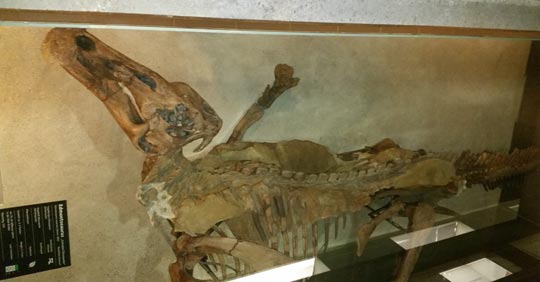Media Co-ordinator Discovers Dinosaur – Hoorah for Amateurs!
Young PR Co-ordinator for Museum Discovers Dinosaur
The discovery of an articulated or associated fossilised skeleton of a large dinosaur can often be the culmination of a lifetimes work for a palaeontologist. A reward for years of fieldwork and painstaking research – or you can simply stumble upon one, by luck.
Recently, a young public relations co-ordinator for the Houston Museum of Natural Science called Steve Cowan, discovered the remains of a duck-billed dinosaur. The animal has been identified as a Brachylophosaurus (means short-crested lizard), a type of hadrosaur that lived approximately 75 million years ago. Compared to other hadrosaurine hadrosaurs such as the later Edmontosaurus, this type of duck-billed dinosaur is relatively rare in the fossil record. It is known from Late Cretaceous deposits (Santonian to Campanian faunal stages) from Alberta and Montana.

Picture credit: Everything Dinosaur
The most complete (a semi-mummified specimen) of Brachylophosaurus was found in the same area in 2000, it is from this fossil that scientists have been able to obtain the most data regarding these relatively rare Hadrosaurs. These particular dinosaurs are believed to have grown to about 7 metres in length and although regarded as duck-bills this term is a bit of a misnomer when referring to this genus. Brachylophosaurus, rather than having the typical hadrosaurine broad, duck-like bill had a more flattened bill which was down-turned, perhaps an adaptation to grazing on a particular type of plant, such as cropping vegetation close to the ground.
Steve has nicknamed this new specimen “Marco”, he was only attending the fossil site in preparation for a media tour being organised to discuss earlier hadrosaur finds in the area. Walking up a ridge he noticed what he thought were bones eroding out of the ridge.
Describing his find as “exciting”, Steve may have to writing a press release in the near future for his own dinosaur discovery. Palaeontologists who have begun to study this location more closely are confident that more bones from this Brachylophosaurus will be found, perhaps even precious skull material. The discovery had been made on a particularly cold, wet day. Sometimes sudden downpours can reveal new fossils quite quickly and the wet fossils can stand out more clearly against the background sediments.
The discovery, a first for Steve, also surprised Robert T. Bakker, curator of palaeontology at the Houston Museum of Natural Sciences, who was leading the expedition.
“One of the things we always need to watch out for is thinking that we know it all,” commented Robert. “I knew enough never to go to a ridge-top because you don’t find specimens there.
“But I forgot to tell that to Steven, so he did exactly that and proved me wrong.”
This particular article reminds us of an incident that happened a few years ago to one of our Everything Dinosaur colleagues whilst on a trip to the Royal Tyrrell museum at Drumheller, Alberta in Canada. They had been visiting the museum and were working on an unrelated project when quite by chance they were invited out for the afternoon into the Dinosaur Provincial Park to accompany some field workers who were going back to a dig site to retrieve some equipment.
The weather had been unsettled for a number of days and there had been some heavy rain in the area, quite an unusual event for what is effectively semi-desert. Jokingly, as the party set off, one of the Canadians remarked to our colleague that with all the heavy rain she might find a new specimen. This was laughed off, the Everything Dinosaur team member, recounting the story remembered commenting that she would not know a fossil even if she fell over it.
However, within a few minutes at arriving at the dig site, our colleague climbed a small bluff to retrieve a piece of tarpaulin that had been blown up there and on the way down stumbled, kicking over some debris that that had been laying half-way up the slope.
To the parties amazement, she had tripped over some articulated hadrosaur vertebrae that had begun to erode out of the bluff. So sometimes, dinosaurs can be found even when you are not actually looking for them, it is really a question of being sharp-eyed and being in the right place at the right time, plus of course relying on the intervention of lady luck.
Everything Dinosaur stocks a large range of duck-billed dinosaur models such as those to be found in the CollectA Prehistoric Life model range: CollectA Age of Dinosaurs Models.

